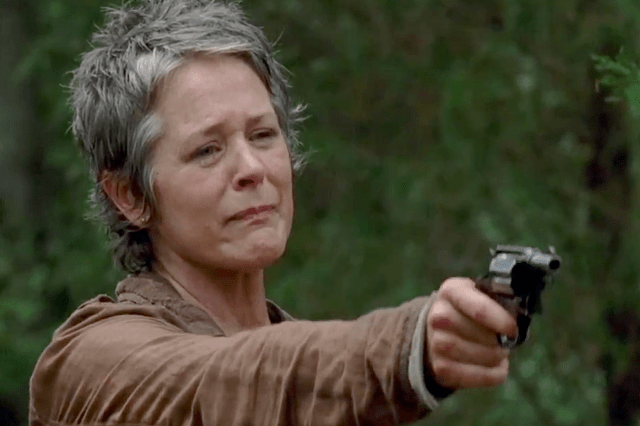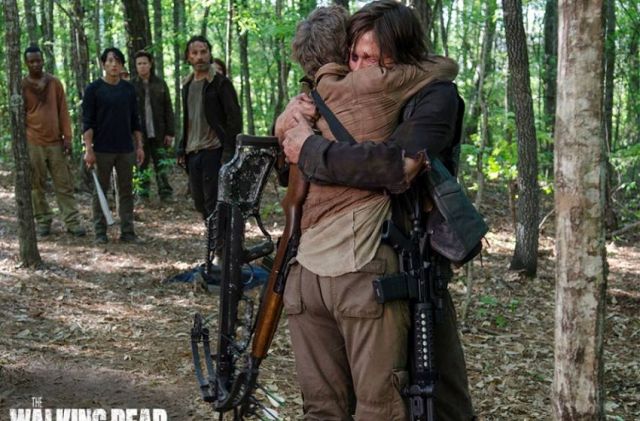Welcome to our Psychology of Inspirational Women series, in which Licensed Clinical Psychologist Dr. Janina Scarlet talks us through the mindset of our favorite female characters. Spoilers for The Walking Dead follow.
The Walking Dead is a popular comic book, video game, and TV series about people trying to survivea zombie (or “walker”) apocalypse. The show revolves around specific group of characters; protagonist Rick Grimes and his crew. But though Rick is the series’ lead, the most inspirational characters in the show are, arguably, Michonne and Carol.
Both women lost their children not long after the outbreak began, and both drastically changed as a result. However, their overall transformations are somewhat opposite of one another.

Michonne
Prior to the outbreak, Michonne seems to have been an easygoing (as can be assumed from her flashbacks) and art-loving person. After her son, Andre Anthony, dies due to her boyfriend Mike’s gross negligence, Michonne watches Mike and his friend, Terry, die from the “zombie” virus. After Mike and Terry reanimate, Michonne cuts off their arms with her katana and disfigures their jaws to prevent them from attacking her, turning them into her pet walkers. Having the two walkers around her masks her scent, making her virtually undetectable to other, predatory walkers.
After spending an indefinite amount of time by herself, Michonne comes across Andrea, a former member of Rick’s group. When Michonne finds her, Andrea is injured, and later becomes extremely sick with the flu. Risking her own life and safety, Michonne nurses Andrea back to health. The two women spend approximately eight months together before they are captured and brought to Woodbury, a city that does not seem to have been affected by the apocalypse. The man running the city is a handsome and charming guy who calls himself The Governor. Michonne immediately distrusts him – she does not trust people easily. Even after all the time they’d spent together, Andrea still complained that she hardly knew her sword-wielding friend.
Michonne’s distrust of The Governor was not without merit, as he turns out to be just about the biggest villain of the series. Manipulative, controlling, and intolerant of anyone who argues with him, The Governor ruthlessly murders anyone who stands in his way. Michonne promises that she will kill him and make him pay for all the damage he caused. She keeps her promise.
After Michonne leaves Woodbury, she joins Rick’s group, and – though at first she distrusts Rick and his crewmembers – Michonne grows to care for them over time. She initially struggles being around Rick’s newborn child, Judith; however, when left alone with the baby, Michonne breaks down and cries, presumably missing her own child.
Michonne had survived on her own by being cold, calculating, and withdrawn. She completely shut down her own feelings, not trusting anyone or allowing anyone get close to her. Despite that, the members of Rick’s group not only take care of Michonne’s wounds but also, on several occasions, risk their lives to save hers. Michonne initially calls their rescuing her “stupid,” as they could have gotten hurt; but as Judith’s caretaker, Beth, reminds Michonne, “When you care about people, hurt is kind of a part of the package.”
Over time, Michonne slowly lets her guard down. At one point she confides in Rick that she misses her deceased friends, Andrea and Hershel, more than she misses her katana, showing that she’s starting to allow herself to become close with her friends. On one occasion, Michonne reveals to Rick’s son, Carl, that it was Rick and Andrea that helped her feel her emotions again. Her growth continues throughout the series and she’s seen slowly recovering from her initial traumas.

Michonne’s diagnosis:
Throughout the series we come to learn more about Michonne’s symptoms and how she’s been coping with her losses. Her symptoms suggest that Michonne might have posttraumatic stress disorder (PTSD). PTSD is a mental health disorder that can occur after someone has experienced a traumatic event, or learns about someone close to him or her who experienced a traumatic event. In order for someone to be diagnosed with PTSD, the symptoms have to last for at least one month.
PTSD symptoms are as follows:
- Intrusions – flashbacks, nightmares, thoughts about what happened. In several episodes, Michonne is shown having nightmares about losing her son, as well as flashbacks and memories about his death. Michonne also used to have hallucinations of her deceased boyfriend, where she would have conversations with him. Although hallucinations are not necessarily a symptom of PTSD, as many as 20% of people with PTSD might develop them.
- Arousal – hypervigilance, irritability, being overly cautious and jumpy. These symptoms describe Michonne to a T.
- Avoidance – refusing to talk or think about the traumatic experiences. When Michonne is first introduced she is withdrawn and distant. She avoids talking about herself and occasionally avoids talking altogether. She initially avoids being around children as well, as they remind her of her son.
Of all the symptoms of PTSD, avoidance is the one most responsible for maintaining this disorder. Not until Michonne stops running from her past and faces her pain does she begin to recover. Allowing herself to open up and trust the members of the group certainly makes Michonne more vulnerable. Yet it is in this vulnerability that she finds her strength. It is by opening herself to love the people around her that Michonne’s broken heart is finally mended.

Carol
Whereas Michonne initially started out as a cold, independent, distrusting killing machine, Carol had a different trajectory. In both the TV series and the comics, Carol is initially in an abusive marriage. In the comics she seems largely dependent on others around her, and would rather be in an abusive relationship than not in one at all. This version of Carol might have something called dependent personality disorder. People with dependent personality disorder tend to be needy; usually don’t speak what’s on their mind for fear of upsetting others; need to be in a relationship or belong to a group; tend to be naïve and child-like; have a hard time with responsibilities and with being alone; and tend to be extremely sensitive, fearing rejection.
In the comics, Carol can’t handle being alone after her husband’s death, and dates (or tries to date) several members of the group. At one point, she actually slashes her wrists in front of her daughter, making me wonder if Carol could possibly have borderline personality disorder (BPD). BPD is characterized by extreme mood swings, relationship instability, low self-esteem, black-and-white thinking (thinking in extremes), impulsivity, and frequent self-injury or threats of self-injury. Overall, it does not appear that Carol has all of these symptoms, whereas a diagnosis of dependent personality disorder still seems highly likely.
On the other hand, the TV version of Carol is entirely different. Just as in the comics, Carol starts out being in an abusive marriage. Her husband, Ed, is violent toward her and her daughter, Sophia, and mistreats other members of the crew. At one point when Carl asks Carol for some food, Ed tells him that they only have enough for their own family and kicks him out. However, Carol manages to sneak out some food for Carl without her husband’s knowledge. Another time Ed slaps his wife for disagreeing with him. When Ed dies after a walker bites him, Carol volunteers to be the one to kill him when he reanimates, and then stabs him repeatedly.
After her daughter is killed, Carol goes through a period of grief, which does not seem to be outside the norm. Initially too devastated to attend her daughter’s funeral, over time Carol comes to make peace with her loss.

Initially meek and helpless, Carol grows into an independent woman, a warrior, and a dear friend. She becomes very skilled with weapons and can look after herself and others. In the prison she teaches the children how to knife walkers and practices a C-section on a female walker in order to help Rick’s wife, Lori, deliver a child.
Carol also seems to have accepted the harsh reality of the group’s situation and does what (in her mind, at least) needs to be done – including killing others when necessary. As painful as it is, Carol has to execute a little girl, Lizzie, due to the child’s severe psychopathy, which makes her a threat to others, especially Judith. Carol also singlehandedly saves Rick and his group from being chopped up and eaten by a group of cannibals at the fake sanctuary, Terminus.
Merle, a previous member of the group, once remarked on how drastically Carol had changed, stating that she used to be like a mouse, afraid of her own shadow. Carol answers that it was Ed’s shadow she was living in.

Indeed, Carol no longer lives in anyone’s shadow and marches to the beat of her own drum. She is dependable, loyal, and a woman of honor. Unlike Michonne and several other characters in the series, Carol does not seem to have symptoms of PTSD. I believe that it was her staying true to her values – taking actions that were most consistent with what was dearest to her – that helped her survive and become more resilient.
Both Carol and Michonne suffer immeasurable losses. The development of their mental health after these losses differs drastically. Whereas Michonne completely shuts down, Carol begins to open up and grow into herself. The main difference between the two women is that Carol embraces her pain and her new role, whereas Michonne runs away from it. Interestingly, once Michonne begins to bond with and open up to the members of the group, she starts recovering. It is not possible to tell what the future will bring for these remarkable women, but one thing we know for certain: social support and connection seem to be key in helping people recover even from the deepest emotional wounds.
If you enjoyed this post, you might also enjoy an upcoming book, Walking Dead Psychology by Sterling publishers, edited by Dr. Travis Langley (Batman and Psychology). The book features the work of many psychologists, including Dr. Scarlet’s chapter on PTSD. The book is scheduled to be released on August 18, 2015.
Dr. Janina Scarlet is a Licensed Clinical Psychologist, a scientist, and a full time geek. She uses Superhero Therapy to help patients with anxiety, depression, chronic pain, and trauma at the Center for Stress and Anxiety Management and Sharp Memorial Hospital. Dr. Scarlet is also a professor at Alliant International University, San Diego. Dr. Scarlet has presented her work at professional psychological conferences, as well as a number of pop culture conventions, such as San Diego Comic-Con. She has authored and co-authored several books, among them the upcoming Walking Dead Psychology.
If you would like to learn more about Superhero Therapy, please feel free to contact Dr. Janina Scarlet via Twitter, Facebook, or via her website at www.superhero-therapy.com.
Are you following The Mary Sue on Twitter, Facebook, Tumblr, Pinterest, & Google +?









